A Comprehensive Analysis of Workplace Mental Health and Wellness
VerifiedAdded on 2023/06/09
|8
|1949
|427
Report
AI Summary
This report examines mental health and wellness programs in various organizations, focusing on program components, activities, and employee assistance programs (EAPs). It explores the inclusion of cultural and ethical considerations in these programs, as well as gender-specific and sexual orientation-specific components. The report evaluates the effectiveness of these programs through available statistics, research outcomes, and measurement methods, highlighting the importance of mindfulness interventions, employee assistance programs, and cultural competency training for counselors. The study emphasizes the positive impact of mental wellness schemes on employee productivity and overall organizational health, advocating for the integration of interactive sessions, informative workshops, and accessible mental health support systems to foster a positive work environment.
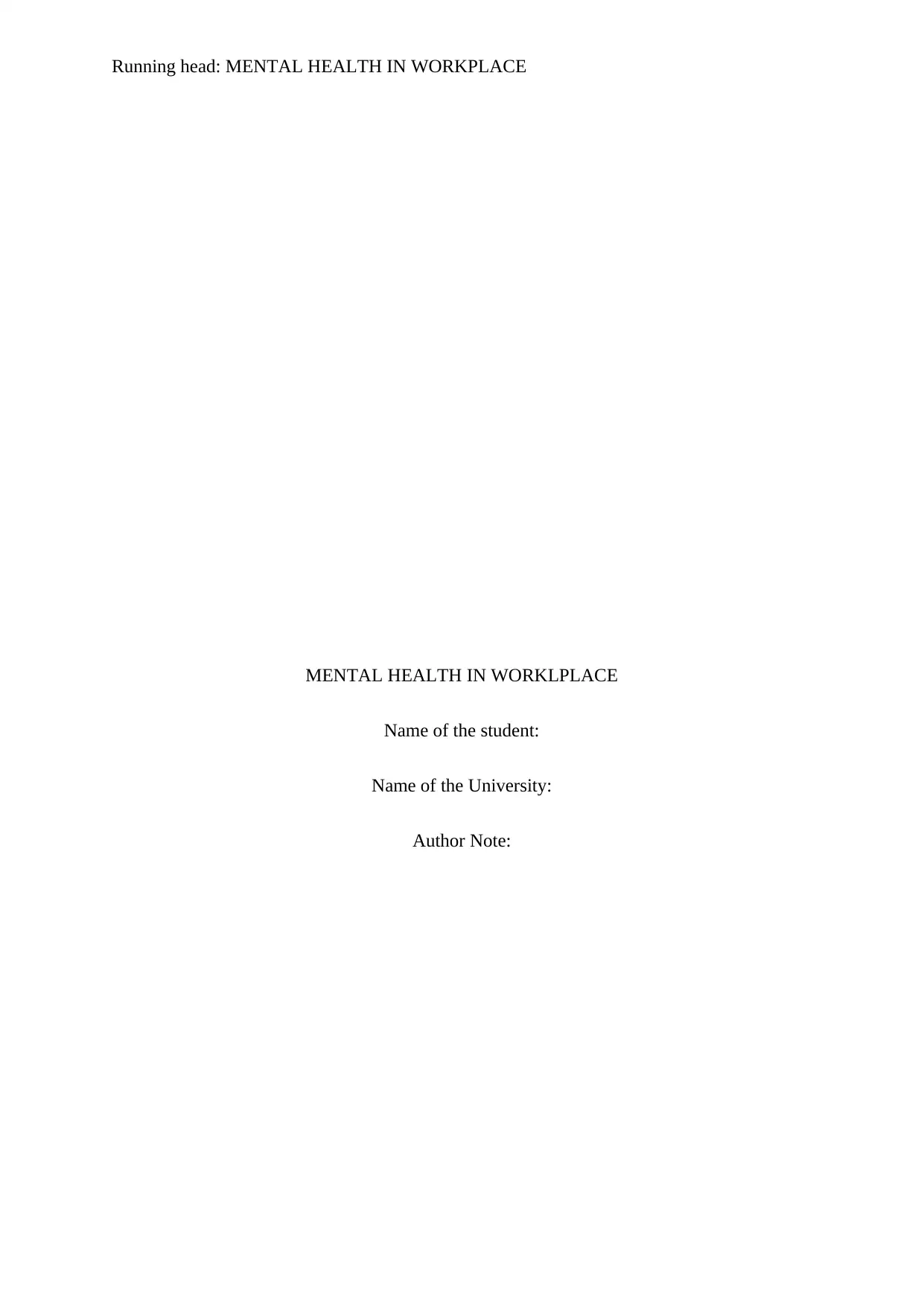
Running head: MENTAL HEALTH IN WORKPLACE
MENTAL HEALTH IN WORKLPLACE
Name of the student:
Name of the University:
Author Note:
MENTAL HEALTH IN WORKLPLACE
Name of the student:
Name of the University:
Author Note:
Secure Best Marks with AI Grader
Need help grading? Try our AI Grader for instant feedback on your assignments.
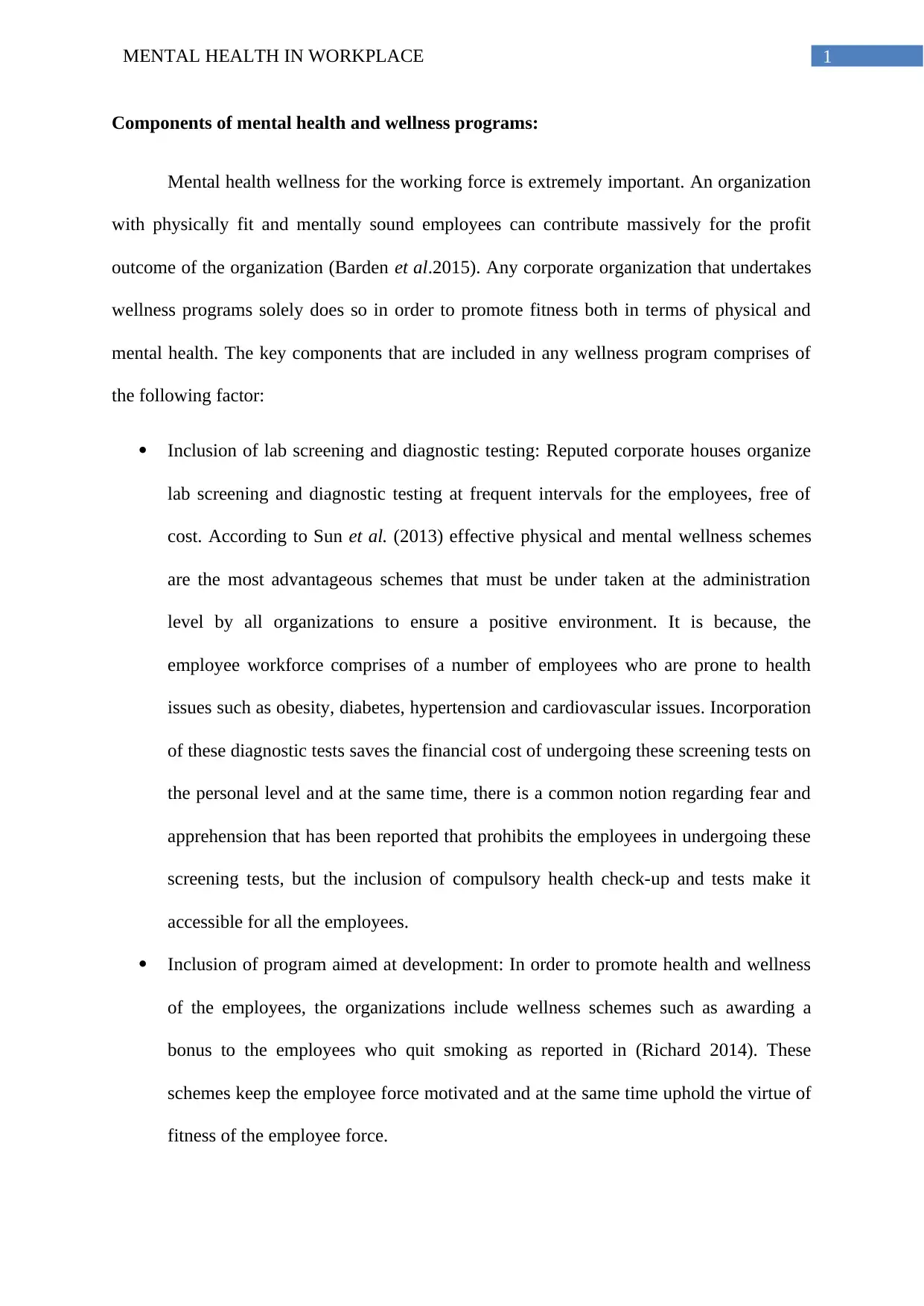
1MENTAL HEALTH IN WORKPLACE
Components of mental health and wellness programs:
Mental health wellness for the working force is extremely important. An organization
with physically fit and mentally sound employees can contribute massively for the profit
outcome of the organization (Barden et al.2015). Any corporate organization that undertakes
wellness programs solely does so in order to promote fitness both in terms of physical and
mental health. The key components that are included in any wellness program comprises of
the following factor:
Inclusion of lab screening and diagnostic testing: Reputed corporate houses organize
lab screening and diagnostic testing at frequent intervals for the employees, free of
cost. According to Sun et al. (2013) effective physical and mental wellness schemes
are the most advantageous schemes that must be under taken at the administration
level by all organizations to ensure a positive environment. It is because, the
employee workforce comprises of a number of employees who are prone to health
issues such as obesity, diabetes, hypertension and cardiovascular issues. Incorporation
of these diagnostic tests saves the financial cost of undergoing these screening tests on
the personal level and at the same time, there is a common notion regarding fear and
apprehension that has been reported that prohibits the employees in undergoing these
screening tests, but the inclusion of compulsory health check-up and tests make it
accessible for all the employees.
Inclusion of program aimed at development: In order to promote health and wellness
of the employees, the organizations include wellness schemes such as awarding a
bonus to the employees who quit smoking as reported in (Richard 2014). These
schemes keep the employee force motivated and at the same time uphold the virtue of
fitness of the employee force.
Components of mental health and wellness programs:
Mental health wellness for the working force is extremely important. An organization
with physically fit and mentally sound employees can contribute massively for the profit
outcome of the organization (Barden et al.2015). Any corporate organization that undertakes
wellness programs solely does so in order to promote fitness both in terms of physical and
mental health. The key components that are included in any wellness program comprises of
the following factor:
Inclusion of lab screening and diagnostic testing: Reputed corporate houses organize
lab screening and diagnostic testing at frequent intervals for the employees, free of
cost. According to Sun et al. (2013) effective physical and mental wellness schemes
are the most advantageous schemes that must be under taken at the administration
level by all organizations to ensure a positive environment. It is because, the
employee workforce comprises of a number of employees who are prone to health
issues such as obesity, diabetes, hypertension and cardiovascular issues. Incorporation
of these diagnostic tests saves the financial cost of undergoing these screening tests on
the personal level and at the same time, there is a common notion regarding fear and
apprehension that has been reported that prohibits the employees in undergoing these
screening tests, but the inclusion of compulsory health check-up and tests make it
accessible for all the employees.
Inclusion of program aimed at development: In order to promote health and wellness
of the employees, the organizations include wellness schemes such as awarding a
bonus to the employees who quit smoking as reported in (Richard 2014). These
schemes keep the employee force motivated and at the same time uphold the virtue of
fitness of the employee force.
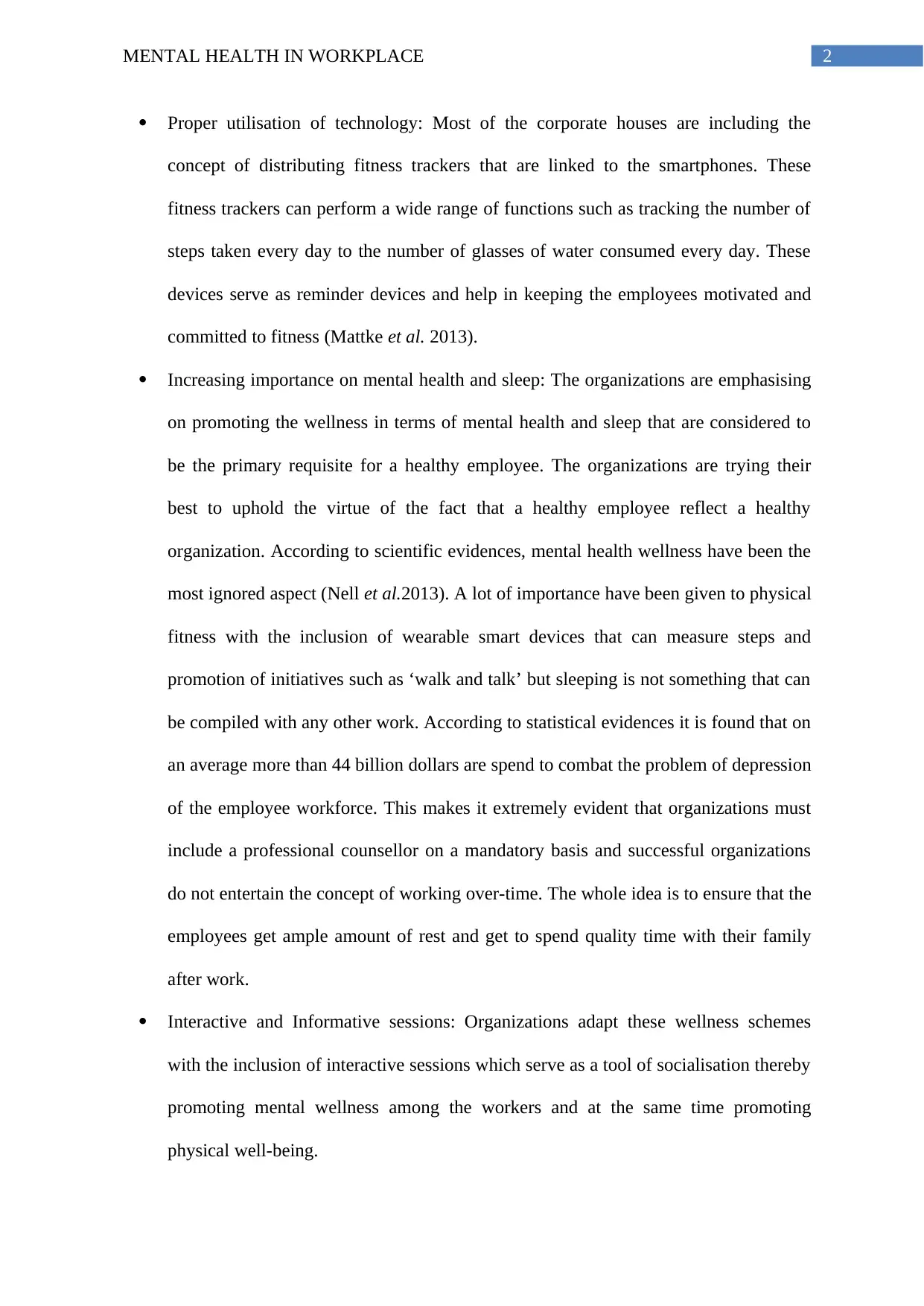
2MENTAL HEALTH IN WORKPLACE
Proper utilisation of technology: Most of the corporate houses are including the
concept of distributing fitness trackers that are linked to the smartphones. These
fitness trackers can perform a wide range of functions such as tracking the number of
steps taken every day to the number of glasses of water consumed every day. These
devices serve as reminder devices and help in keeping the employees motivated and
committed to fitness (Mattke et al. 2013).
Increasing importance on mental health and sleep: The organizations are emphasising
on promoting the wellness in terms of mental health and sleep that are considered to
be the primary requisite for a healthy employee. The organizations are trying their
best to uphold the virtue of the fact that a healthy employee reflect a healthy
organization. According to scientific evidences, mental health wellness have been the
most ignored aspect (Nell et al.2013). A lot of importance have been given to physical
fitness with the inclusion of wearable smart devices that can measure steps and
promotion of initiatives such as ‘walk and talk’ but sleeping is not something that can
be compiled with any other work. According to statistical evidences it is found that on
an average more than 44 billion dollars are spend to combat the problem of depression
of the employee workforce. This makes it extremely evident that organizations must
include a professional counsellor on a mandatory basis and successful organizations
do not entertain the concept of working over-time. The whole idea is to ensure that the
employees get ample amount of rest and get to spend quality time with their family
after work.
Interactive and Informative sessions: Organizations adapt these wellness schemes
with the inclusion of interactive sessions which serve as a tool of socialisation thereby
promoting mental wellness among the workers and at the same time promoting
physical well-being.
Proper utilisation of technology: Most of the corporate houses are including the
concept of distributing fitness trackers that are linked to the smartphones. These
fitness trackers can perform a wide range of functions such as tracking the number of
steps taken every day to the number of glasses of water consumed every day. These
devices serve as reminder devices and help in keeping the employees motivated and
committed to fitness (Mattke et al. 2013).
Increasing importance on mental health and sleep: The organizations are emphasising
on promoting the wellness in terms of mental health and sleep that are considered to
be the primary requisite for a healthy employee. The organizations are trying their
best to uphold the virtue of the fact that a healthy employee reflect a healthy
organization. According to scientific evidences, mental health wellness have been the
most ignored aspect (Nell et al.2013). A lot of importance have been given to physical
fitness with the inclusion of wearable smart devices that can measure steps and
promotion of initiatives such as ‘walk and talk’ but sleeping is not something that can
be compiled with any other work. According to statistical evidences it is found that on
an average more than 44 billion dollars are spend to combat the problem of depression
of the employee workforce. This makes it extremely evident that organizations must
include a professional counsellor on a mandatory basis and successful organizations
do not entertain the concept of working over-time. The whole idea is to ensure that the
employees get ample amount of rest and get to spend quality time with their family
after work.
Interactive and Informative sessions: Organizations adapt these wellness schemes
with the inclusion of interactive sessions which serve as a tool of socialisation thereby
promoting mental wellness among the workers and at the same time promoting
physical well-being.
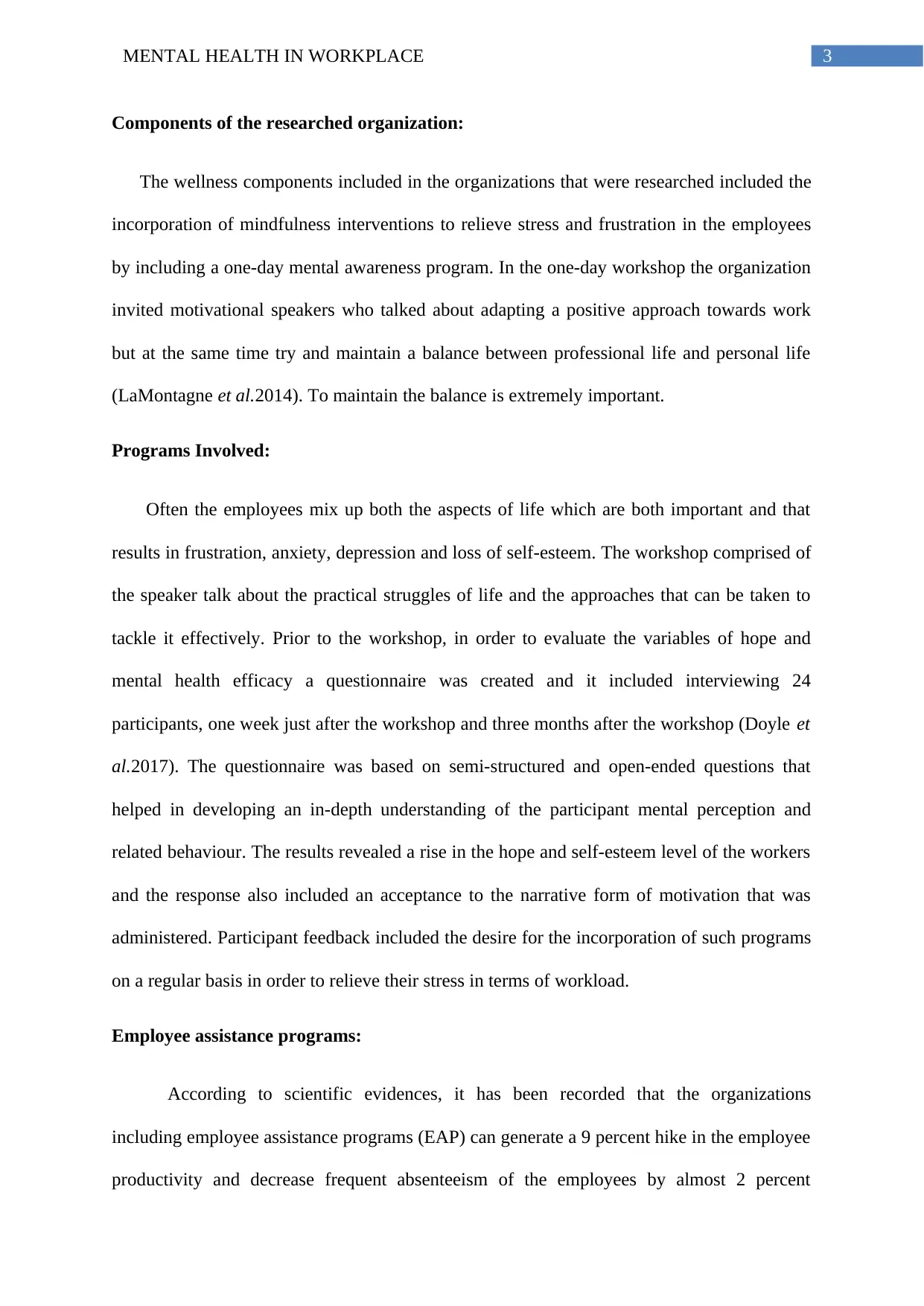
3MENTAL HEALTH IN WORKPLACE
Components of the researched organization:
The wellness components included in the organizations that were researched included the
incorporation of mindfulness interventions to relieve stress and frustration in the employees
by including a one-day mental awareness program. In the one-day workshop the organization
invited motivational speakers who talked about adapting a positive approach towards work
but at the same time try and maintain a balance between professional life and personal life
(LaMontagne et al.2014). To maintain the balance is extremely important.
Programs Involved:
Often the employees mix up both the aspects of life which are both important and that
results in frustration, anxiety, depression and loss of self-esteem. The workshop comprised of
the speaker talk about the practical struggles of life and the approaches that can be taken to
tackle it effectively. Prior to the workshop, in order to evaluate the variables of hope and
mental health efficacy a questionnaire was created and it included interviewing 24
participants, one week just after the workshop and three months after the workshop (Doyle et
al.2017). The questionnaire was based on semi-structured and open-ended questions that
helped in developing an in-depth understanding of the participant mental perception and
related behaviour. The results revealed a rise in the hope and self-esteem level of the workers
and the response also included an acceptance to the narrative form of motivation that was
administered. Participant feedback included the desire for the incorporation of such programs
on a regular basis in order to relieve their stress in terms of workload.
Employee assistance programs:
According to scientific evidences, it has been recorded that the organizations
including employee assistance programs (EAP) can generate a 9 percent hike in the employee
productivity and decrease frequent absenteeism of the employees by almost 2 percent
Components of the researched organization:
The wellness components included in the organizations that were researched included the
incorporation of mindfulness interventions to relieve stress and frustration in the employees
by including a one-day mental awareness program. In the one-day workshop the organization
invited motivational speakers who talked about adapting a positive approach towards work
but at the same time try and maintain a balance between professional life and personal life
(LaMontagne et al.2014). To maintain the balance is extremely important.
Programs Involved:
Often the employees mix up both the aspects of life which are both important and that
results in frustration, anxiety, depression and loss of self-esteem. The workshop comprised of
the speaker talk about the practical struggles of life and the approaches that can be taken to
tackle it effectively. Prior to the workshop, in order to evaluate the variables of hope and
mental health efficacy a questionnaire was created and it included interviewing 24
participants, one week just after the workshop and three months after the workshop (Doyle et
al.2017). The questionnaire was based on semi-structured and open-ended questions that
helped in developing an in-depth understanding of the participant mental perception and
related behaviour. The results revealed a rise in the hope and self-esteem level of the workers
and the response also included an acceptance to the narrative form of motivation that was
administered. Participant feedback included the desire for the incorporation of such programs
on a regular basis in order to relieve their stress in terms of workload.
Employee assistance programs:
According to scientific evidences, it has been recorded that the organizations
including employee assistance programs (EAP) can generate a 9 percent hike in the employee
productivity and decrease frequent absenteeism of the employees by almost 2 percent
Secure Best Marks with AI Grader
Need help grading? Try our AI Grader for instant feedback on your assignments.
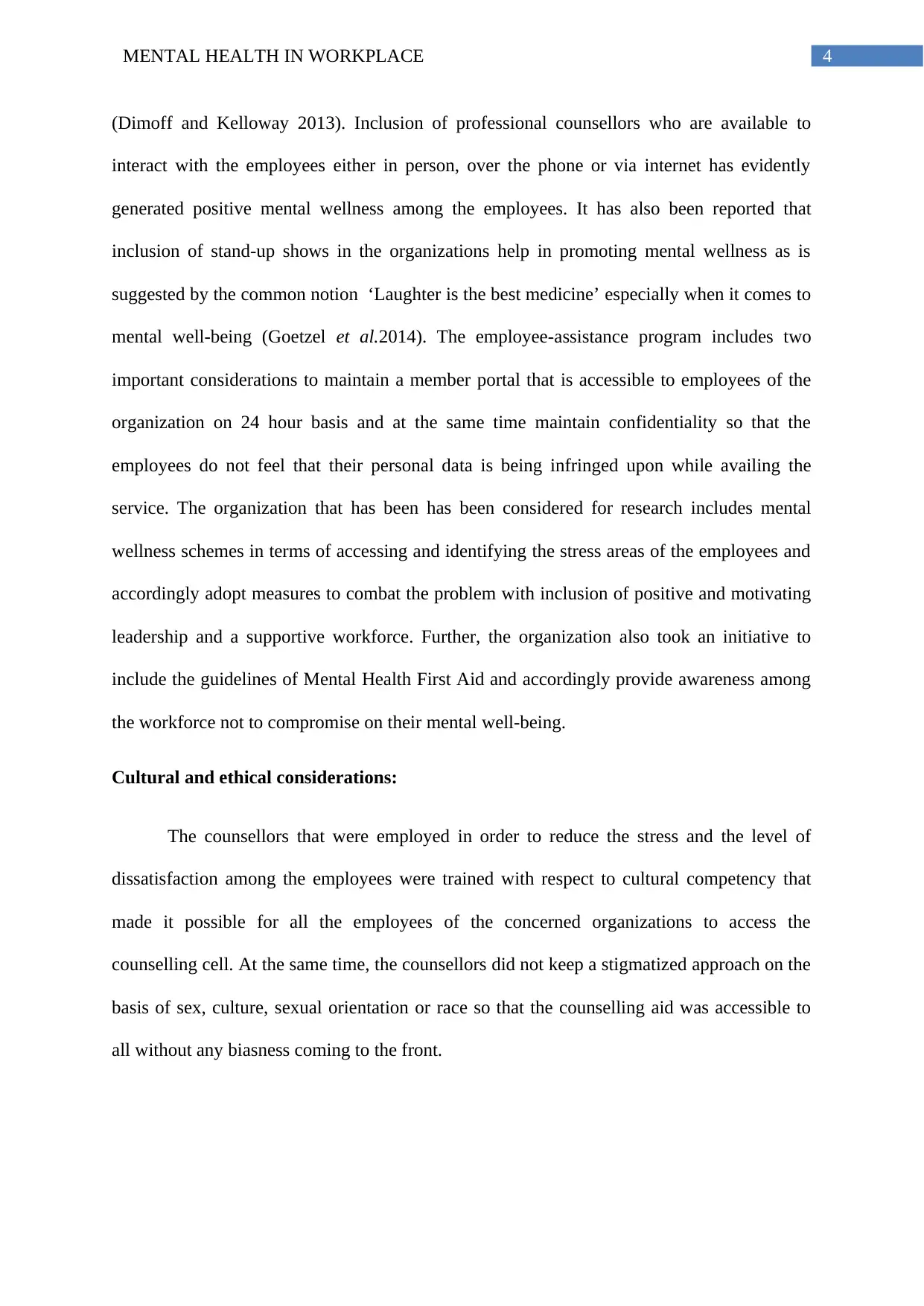
4MENTAL HEALTH IN WORKPLACE
(Dimoff and Kelloway 2013). Inclusion of professional counsellors who are available to
interact with the employees either in person, over the phone or via internet has evidently
generated positive mental wellness among the employees. It has also been reported that
inclusion of stand-up shows in the organizations help in promoting mental wellness as is
suggested by the common notion ‘Laughter is the best medicine’ especially when it comes to
mental well-being (Goetzel et al.2014). The employee-assistance program includes two
important considerations to maintain a member portal that is accessible to employees of the
organization on 24 hour basis and at the same time maintain confidentiality so that the
employees do not feel that their personal data is being infringed upon while availing the
service. The organization that has been has been considered for research includes mental
wellness schemes in terms of accessing and identifying the stress areas of the employees and
accordingly adopt measures to combat the problem with inclusion of positive and motivating
leadership and a supportive workforce. Further, the organization also took an initiative to
include the guidelines of Mental Health First Aid and accordingly provide awareness among
the workforce not to compromise on their mental well-being.
Cultural and ethical considerations:
The counsellors that were employed in order to reduce the stress and the level of
dissatisfaction among the employees were trained with respect to cultural competency that
made it possible for all the employees of the concerned organizations to access the
counselling cell. At the same time, the counsellors did not keep a stigmatized approach on the
basis of sex, culture, sexual orientation or race so that the counselling aid was accessible to
all without any biasness coming to the front.
(Dimoff and Kelloway 2013). Inclusion of professional counsellors who are available to
interact with the employees either in person, over the phone or via internet has evidently
generated positive mental wellness among the employees. It has also been reported that
inclusion of stand-up shows in the organizations help in promoting mental wellness as is
suggested by the common notion ‘Laughter is the best medicine’ especially when it comes to
mental well-being (Goetzel et al.2014). The employee-assistance program includes two
important considerations to maintain a member portal that is accessible to employees of the
organization on 24 hour basis and at the same time maintain confidentiality so that the
employees do not feel that their personal data is being infringed upon while availing the
service. The organization that has been has been considered for research includes mental
wellness schemes in terms of accessing and identifying the stress areas of the employees and
accordingly adopt measures to combat the problem with inclusion of positive and motivating
leadership and a supportive workforce. Further, the organization also took an initiative to
include the guidelines of Mental Health First Aid and accordingly provide awareness among
the workforce not to compromise on their mental well-being.
Cultural and ethical considerations:
The counsellors that were employed in order to reduce the stress and the level of
dissatisfaction among the employees were trained with respect to cultural competency that
made it possible for all the employees of the concerned organizations to access the
counselling cell. At the same time, the counsellors did not keep a stigmatized approach on the
basis of sex, culture, sexual orientation or race so that the counselling aid was accessible to
all without any biasness coming to the front.
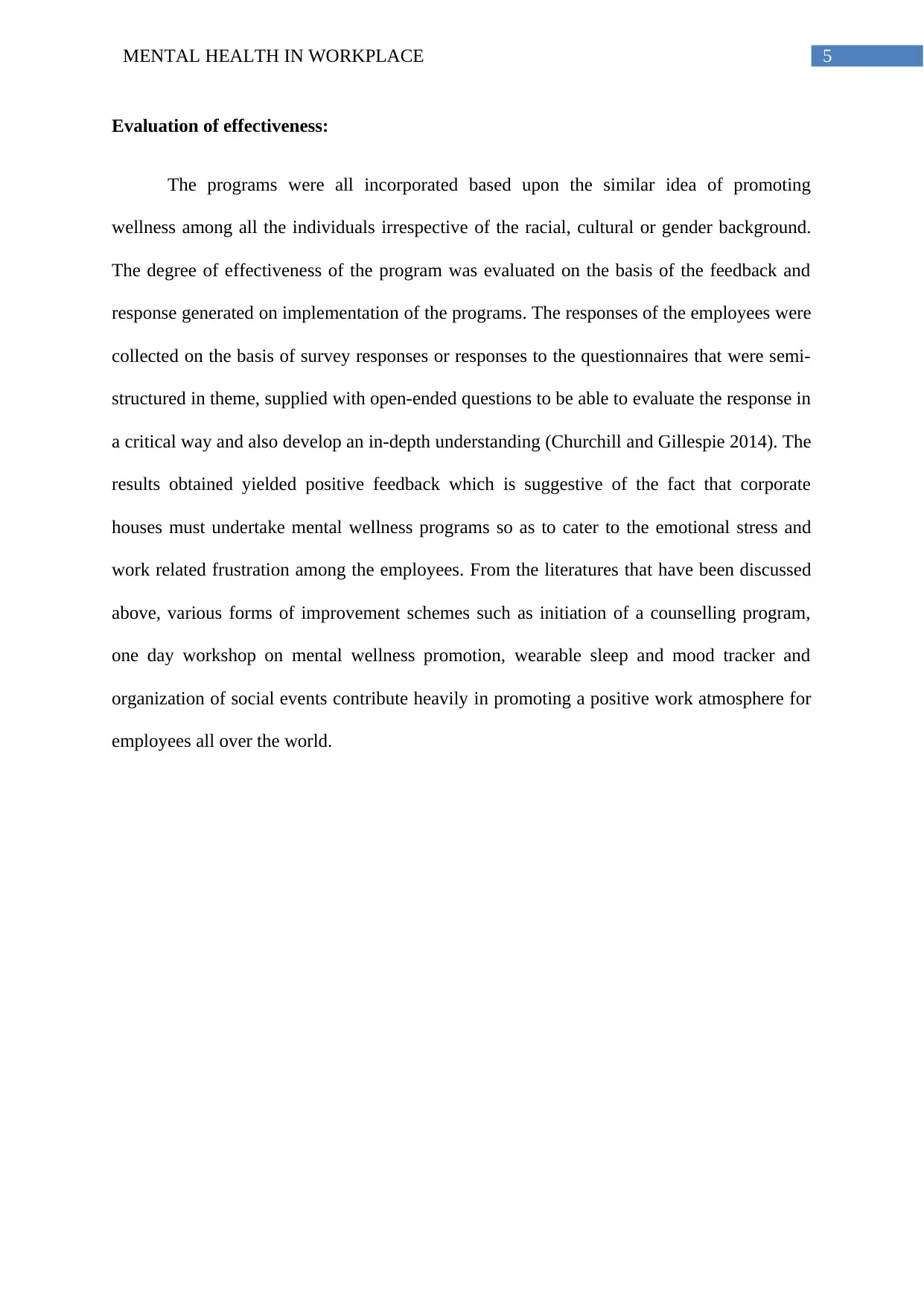
5MENTAL HEALTH IN WORKPLACE
Evaluation of effectiveness:
The programs were all incorporated based upon the similar idea of promoting
wellness among all the individuals irrespective of the racial, cultural or gender background.
The degree of effectiveness of the program was evaluated on the basis of the feedback and
response generated on implementation of the programs. The responses of the employees were
collected on the basis of survey responses or responses to the questionnaires that were semi-
structured in theme, supplied with open-ended questions to be able to evaluate the response in
a critical way and also develop an in-depth understanding (Churchill and Gillespie 2014). The
results obtained yielded positive feedback which is suggestive of the fact that corporate
houses must undertake mental wellness programs so as to cater to the emotional stress and
work related frustration among the employees. From the literatures that have been discussed
above, various forms of improvement schemes such as initiation of a counselling program,
one day workshop on mental wellness promotion, wearable sleep and mood tracker and
organization of social events contribute heavily in promoting a positive work atmosphere for
employees all over the world.
Evaluation of effectiveness:
The programs were all incorporated based upon the similar idea of promoting
wellness among all the individuals irrespective of the racial, cultural or gender background.
The degree of effectiveness of the program was evaluated on the basis of the feedback and
response generated on implementation of the programs. The responses of the employees were
collected on the basis of survey responses or responses to the questionnaires that were semi-
structured in theme, supplied with open-ended questions to be able to evaluate the response in
a critical way and also develop an in-depth understanding (Churchill and Gillespie 2014). The
results obtained yielded positive feedback which is suggestive of the fact that corporate
houses must undertake mental wellness programs so as to cater to the emotional stress and
work related frustration among the employees. From the literatures that have been discussed
above, various forms of improvement schemes such as initiation of a counselling program,
one day workshop on mental wellness promotion, wearable sleep and mood tracker and
organization of social events contribute heavily in promoting a positive work atmosphere for
employees all over the world.
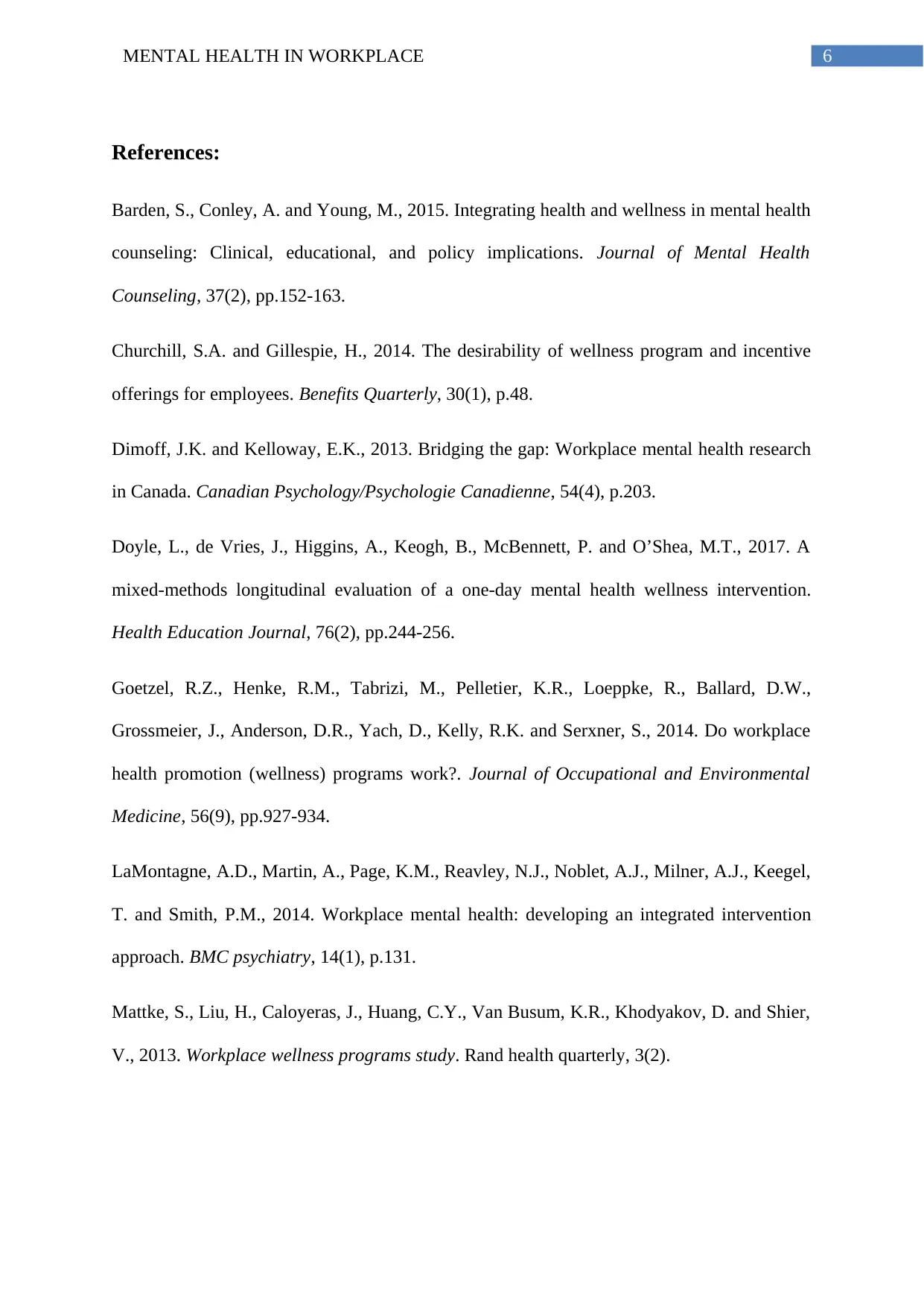
6MENTAL HEALTH IN WORKPLACE
References:
Barden, S., Conley, A. and Young, M., 2015. Integrating health and wellness in mental health
counseling: Clinical, educational, and policy implications. Journal of Mental Health
Counseling, 37(2), pp.152-163.
Churchill, S.A. and Gillespie, H., 2014. The desirability of wellness program and incentive
offerings for employees. Benefits Quarterly, 30(1), p.48.
Dimoff, J.K. and Kelloway, E.K., 2013. Bridging the gap: Workplace mental health research
in Canada. Canadian Psychology/Psychologie Canadienne, 54(4), p.203.
Doyle, L., de Vries, J., Higgins, A., Keogh, B., McBennett, P. and O’Shea, M.T., 2017. A
mixed-methods longitudinal evaluation of a one-day mental health wellness intervention.
Health Education Journal, 76(2), pp.244-256.
Goetzel, R.Z., Henke, R.M., Tabrizi, M., Pelletier, K.R., Loeppke, R., Ballard, D.W.,
Grossmeier, J., Anderson, D.R., Yach, D., Kelly, R.K. and Serxner, S., 2014. Do workplace
health promotion (wellness) programs work?. Journal of Occupational and Environmental
Medicine, 56(9), pp.927-934.
LaMontagne, A.D., Martin, A., Page, K.M., Reavley, N.J., Noblet, A.J., Milner, A.J., Keegel,
T. and Smith, P.M., 2014. Workplace mental health: developing an integrated intervention
approach. BMC psychiatry, 14(1), p.131.
Mattke, S., Liu, H., Caloyeras, J., Huang, C.Y., Van Busum, K.R., Khodyakov, D. and Shier,
V., 2013. Workplace wellness programs study. Rand health quarterly, 3(2).
References:
Barden, S., Conley, A. and Young, M., 2015. Integrating health and wellness in mental health
counseling: Clinical, educational, and policy implications. Journal of Mental Health
Counseling, 37(2), pp.152-163.
Churchill, S.A. and Gillespie, H., 2014. The desirability of wellness program and incentive
offerings for employees. Benefits Quarterly, 30(1), p.48.
Dimoff, J.K. and Kelloway, E.K., 2013. Bridging the gap: Workplace mental health research
in Canada. Canadian Psychology/Psychologie Canadienne, 54(4), p.203.
Doyle, L., de Vries, J., Higgins, A., Keogh, B., McBennett, P. and O’Shea, M.T., 2017. A
mixed-methods longitudinal evaluation of a one-day mental health wellness intervention.
Health Education Journal, 76(2), pp.244-256.
Goetzel, R.Z., Henke, R.M., Tabrizi, M., Pelletier, K.R., Loeppke, R., Ballard, D.W.,
Grossmeier, J., Anderson, D.R., Yach, D., Kelly, R.K. and Serxner, S., 2014. Do workplace
health promotion (wellness) programs work?. Journal of Occupational and Environmental
Medicine, 56(9), pp.927-934.
LaMontagne, A.D., Martin, A., Page, K.M., Reavley, N.J., Noblet, A.J., Milner, A.J., Keegel,
T. and Smith, P.M., 2014. Workplace mental health: developing an integrated intervention
approach. BMC psychiatry, 14(1), p.131.
Mattke, S., Liu, H., Caloyeras, J., Huang, C.Y., Van Busum, K.R., Khodyakov, D. and Shier,
V., 2013. Workplace wellness programs study. Rand health quarterly, 3(2).
Paraphrase This Document
Need a fresh take? Get an instant paraphrase of this document with our AI Paraphraser
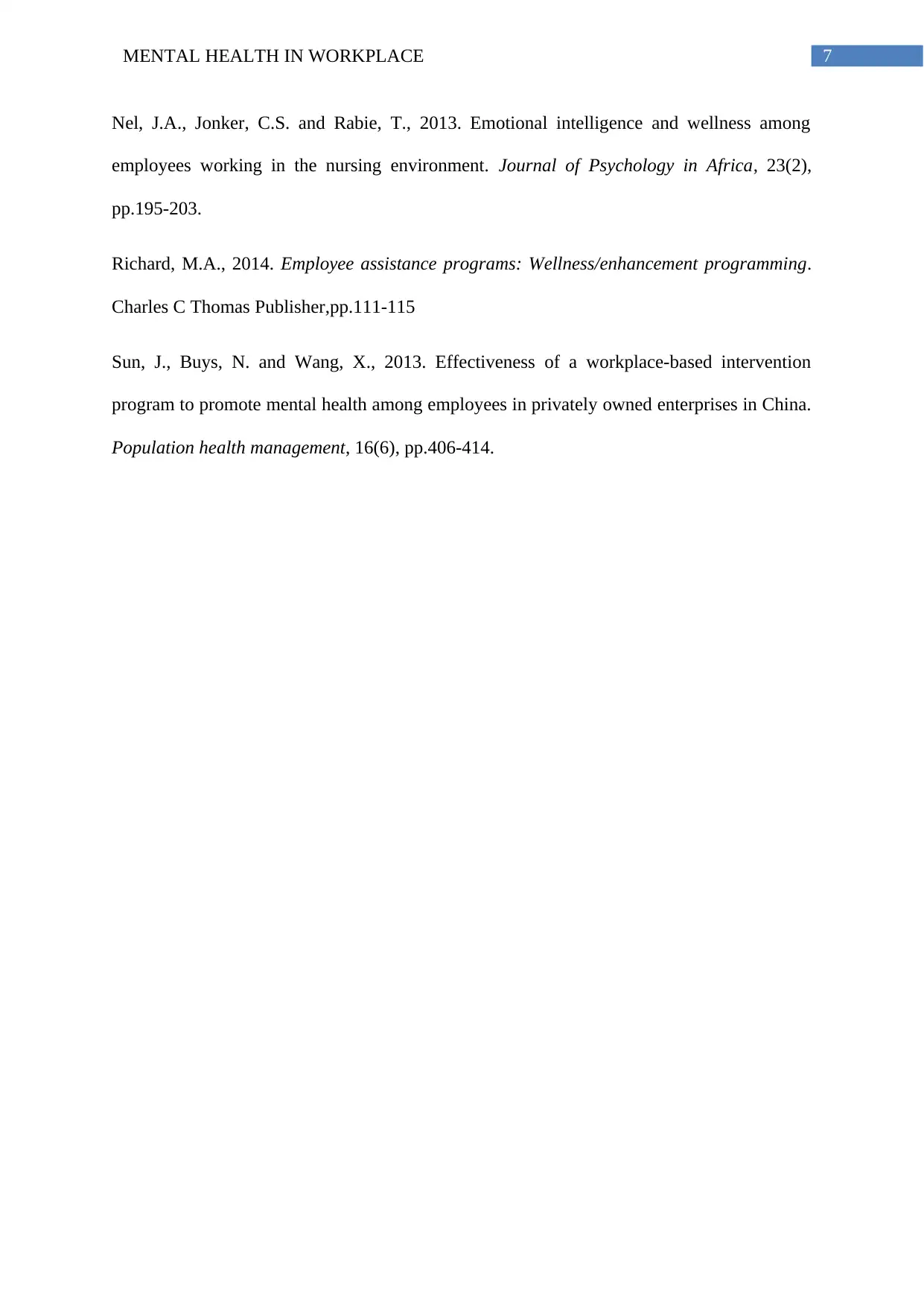
7MENTAL HEALTH IN WORKPLACE
Nel, J.A., Jonker, C.S. and Rabie, T., 2013. Emotional intelligence and wellness among
employees working in the nursing environment. Journal of Psychology in Africa, 23(2),
pp.195-203.
Richard, M.A., 2014. Employee assistance programs: Wellness/enhancement programming.
Charles C Thomas Publisher,pp.111-115
Sun, J., Buys, N. and Wang, X., 2013. Effectiveness of a workplace-based intervention
program to promote mental health among employees in privately owned enterprises in China.
Population health management, 16(6), pp.406-414.
Nel, J.A., Jonker, C.S. and Rabie, T., 2013. Emotional intelligence and wellness among
employees working in the nursing environment. Journal of Psychology in Africa, 23(2),
pp.195-203.
Richard, M.A., 2014. Employee assistance programs: Wellness/enhancement programming.
Charles C Thomas Publisher,pp.111-115
Sun, J., Buys, N. and Wang, X., 2013. Effectiveness of a workplace-based intervention
program to promote mental health among employees in privately owned enterprises in China.
Population health management, 16(6), pp.406-414.
1 out of 8
Related Documents
Your All-in-One AI-Powered Toolkit for Academic Success.
+13062052269
info@desklib.com
Available 24*7 on WhatsApp / Email
![[object Object]](/_next/static/media/star-bottom.7253800d.svg)
Unlock your academic potential
© 2024 | Zucol Services PVT LTD | All rights reserved.




